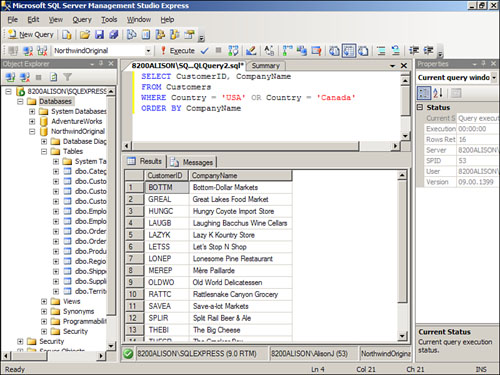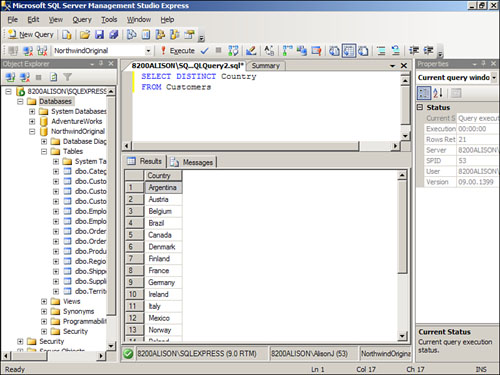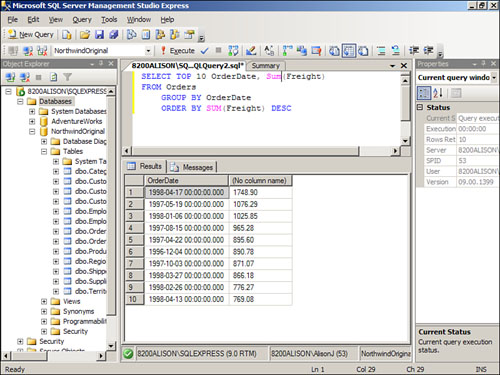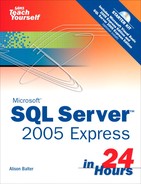HOUR 6. Getting to Know the SELECT Statement
Knowledge of the T-SQL language is vital to your success as a SQL Express administrator or developer. You use the T-SQL language to manipulate the data in your database. Using T-SQL, you can select, insert, update, and delete data. In this hour you’ll learn:
• How to Build a SELECT Statement
• How to Work with a WHERE Clause
• How to Work with the DISTINCT Clause
• How to Output Your Data as XML
• How to Create Top Values Queries
Introducing T-SQL
T-SQL, or Transact-SQL, is the dialect of the Structured Query Language (SQL) incorporated in SQL Server. To work effectively as a SQL Server developer, you must have a strong grasp of T-SQL. Fortunately, T-SQL is easy to learn. When retrieving data, you simply build a SELECT statement. SELECT statements are composed of clauses that determine the specifics of how the data is selected. When they’re executed, SELECT statements select rows of data and return them as a recordset.
By the Way
In the examples that follow, keywords appear in uppercase. Values that you supply appear italicized. Optional parts of the statement appear in square brackets. Curly braces, combined with vertical bars, indicate a choice. Finally, ellipses are used to indicate a repeating sequence.
By the Way
The examples that follow are based on a database called Northwind which is included on the sample code CD. Instructions as to how to install the Northwind database are included in Appendix A.
Working with the SELECT Statement
The SELECT statement is at the heart of the SQL language. You use the SELECT statement to retrieve data from one or more tables. Its basic syntax is
SELECT column-list FROM table-list WHERE where-clause ORDER BY order-by-clause
The SELECT clause specifies what columns you want to retrieve from the table that SQL Server returns to the result set. The basic syntax for a SELECT clause is
SELECT column-list
The simplest SELECT clause looks like this:
SELECT * FROM Customers
This SELECT clause, combined with the FROM clause covered next, retrieves all columns from a table. Here’s another example that retrieves only the CustomerID and CompanyName columns from a table:
SELECT CustomerID, CompanyName FROM Customers
Not only can you include columns that exist in your table, but you also can include expressions in a SELECT clause. Here’s an example:
SELECT CustomerID, City + ', ' + Region + ' ' +
PostalCode AS Address FROM Customers
This SELECT clause retrieves the CustomerID column as well as an alias called Address, which includes an expression that concatenates the City, Region, and PostalCode columns (see Figure 6.1).
Figure 6.1. A SELECT clause that retrieves the CustomerID column as well as an alias called Address, which includes an expression that concatenates the City, Region, and PostalCode columns.

Adding on the FROM Clause
The FROM clause specifies the tables or views from which the records should be selected. It can include an alias that you use to refer to the table. The FROM clause looks like this:
FROM table-list [AS alias]
Here’s an example of a basic FROM clause:
FROM Customers
In this case, the name of the table is Customers. If you combine the SELECT clause with the FROM clause, the SQL statement looks like this:
SELECT CustomerID, CompanyName FROM Customers
This SELECT statement retrieves the CustomerID and CompanyName columns from the Customers table.
Just as you can alias the fields included in a SELECT clause, you can also alias the tables included in the FROM clause. The alias is used to shorten the name and to simplify a cryptic name, as well as for a variety of other reasons. Here’s an example:
SELECT CustomerID, CompanyName FROM Customers AS Clients
Including the WHERE Clause
The WHERE clause limits the records retrieved by the SELECT statement. A WHERE clause can include columns combined by the keywords AND and OR. The syntax for a WHERE clause looks like this:
WHERE expression1 [{AND|OR} expression2 [...]]
A simple WHERE clause looks like this:
WHERE Country = 'USA'
Using an AND to further limit the criteria, the WHERE clause looks like this:
WHERE Country = 'USA' AND ContactTitle Like 'Sales%'
This WHERE clause limits the records returned to those in which the country is equal to USA and the ContactTitle begins with Sales. Notice that T-SQL uses the percent (%) sign as a wildcard. Using an OR, the SELECT statement looks like this:
WHERE Country = 'USA' OR Country = 'Canada'
This WHERE clause returns all records in which the country is equal to either USA or Canada. Compare that with the following example:
WHERE Country = 'USA' OR ContactTitle Like 'Sales%'
This WHERE clause returns all records in which the country is equal to USA or the ContactTitle begins with Sales. For example, the salespeople in China are returned from this WHERE clause because their ContactTitle begins with Sales. The WHERE clause combined with the SELECT and FROM clauses looks like this (see also Figure 6.2):
SELECT CustomerID, CompanyName FROM Customers
WHERE Country = 'USA' OR Country = 'Canada'
Figure 6.2. A SELECT clause that retrieves the CustomerID and CompanyName columns for all the customers in the U.S.A. and Canada.

You must follow several rules when building a WHERE clause. You must enclose the text strings for which you are searching in apostrophes. You must also surround dates with apostrophes. Finally, you must include the keyword LIKE when utilizing wildcard characters. Remember that T-SQL uses the percent symbol as the wildcard for zero or more characters. The underscore (_) is the wildcard for a single character.
Using the ORDER BY Clause
The ORDER BY clause determines the order in which SQL Server sorts the returned rows. It’s an optional clause and looks like this:
ORDER BY column1 [{ASC|DESC}], column2 [{ASC|DESC}] [,...]]
Here’s an example:
ORDER BY CustomerID
The ORDER BY clause can include more than one field:
ORDER BY Country, CustomerID
When you specify more than one field, SQL Server uses the leftmost field as the primary level of sort. Any additional fields are the lower sort levels. Combined with the rest of the SELECT statement, the ORDER BY clause looks like this:
SELECT CustomerID, CompanyName FROM Customers
WHERE Country = 'USA' OR Country = 'Canada'
ORDER BY CompanyName
The results appear in order by CompanyName (see Figure 6.3).
Figure 6.3. A SELECT clause that retrieves the CustomerID and CompanyName columns for all the customers in the U.S.A. and Canada. SQL Server orders the results by CompanyName.

The ORDER BY clause enables you to determine whether the sorted output appears in ascending or descending order. By default, output appears in ascending order. To switch to descending order, use the optional keyword DESC. Here’s an example:
SELECT CustomerID, CompanyName FROM Customers ORDER BY CustomerID DESC
This example selects the CustomerID and CompanyName fields from the Customers table, ordering the output in descending order by the CustomerID field (see Figure 6.4).
Figure 6.4. A SELECT clause that retrieves the CustomerID and CompanyName columns for all the customers in the U.S.A. and Canada. SQL Server orders the results in descending order by CustomerID.

Adding the DISTINCT Keyword
The DISTINCT keyword ensures uniqueness of values in the column or combination of columns included in the query result. Consider the following SQL statement:
SELECT Country FROM Customers
This statement returns one row for each customer (see Figure 6.5). The same country appears multiple times in the output.
Figure 6.5. A SELECT statement that returns one row for each customer. The same country appears multiple times in the output.

Contrast the statement used in Figure 6.5 with this:
SELECT DISTINCT Country FROM Customers
This statement returns a list of unique countries from the list of customers (see Figure 6.6).
Figure 6.6. A SELECT statement that returns a list of unique countries from the list of customers.

The statement that follows returns a unique list of country and city combinations (see Figure 6.7):
SELECT DISTINCT Country, City FROM customers
Figure 6.7. A SELECT statement that returns a list of unique country and city combinations from the list of customers.

Working with the FOR XML Clause
You use the FOR XML clause to return data as an XML document. When using the FOR XML clause, you must specify the mode as RAW, AUTO, or EXPLICIT. With the RAW option, SQL Server takes the result of the query and transforms each row in the result set into an XML element with a generic identifier. Here’s an example:
SELECT CustomerID, CompanyName, ContactName, ContactTitle
FROM Customers
ORDER BY CustomerID
FOR XML RAW
The results appear as in Figure 6.8. With the AUTO option, SQL Server returns a simple nested XML tree. SQL Server represents each field in each table specified in the SELECT clause as an XML element. Here’s an example:
Figure 6.8. The result of using the FOR XML RAW clause to return data.

SELECT CustomerID, CompanyName, ContactName, ContactTitle
FROM Customers
ORDER BY CustomerID
FOR XML AUTO
The results appear as in Figure 6.9. Finally, with the EXPLICIT option, you explicitly define the shape of the tree. You must write your queries so that the columns listed in the SELECT clause are mapped to the appropriate element attributes.
Figure 6.9. The result of using the FOR XML AUTO clause to return data.

Creating Top Values Queries
You use the TOP clause to limit the number of rows that SQL Server includes in the output. Here’s an example:
SELECT TOP 10 OrderDate, Freight FROM Orders
ORDER BY Freight DESC
This example shows the 10 highest freight amounts along with their corresponding order dates (see Figure 6.10).
Figure 6.10. A SELECT statement that shows the 10 order dates associated with the highest 10 freight amounts.

In addition to enabling you to select the top number of rows, T-SQL also enables you to select the top percent of rows. Here’s an example:
SELECT TOP 10 PERCENT OrderDate, Freight FROM Orders
ORDER BY Freight DESC
Here the top 10% of freight amounts appear in the query result.
Summary
The T-SQL language is the foundation for most of what you do in SQL Server. It is therefore necessary that you have a strong understanding of the T-SQL language constructs. This chapter covered many of the basics of the T-SQL language. You learned about the SELECT statement, the FROM keyword, the WHERE clause, the ORDER BY clause, and the DISTINCT keyword. You also learned about FOR XML and top value queries. We cover T-SQL in additional detail throughout the remainder of the book.
Q&A
Q. Why do you use a SELECT statement?
A. You use the SELECT statement to retrieve data from one or more tables.
Q. Name the wildcard characters that you can use when searching, and explain the differences between them.
A. The two wildcard characters are the percent (%) sign and the underscore (_). T-SQL uses the percent symbol as the wildcard for zero or more characters. The underscore (_) is the wildcard for a single character.
Q. Explain the DISTINCT keyword.
A. The DISTINCT keyword ensures uniqueness of values in the column or combination of columns included in the query result.
Q. Why would you use a Top Values query?
A. You use a Top Values query to limit the number of rows that appear in the output.
Workshop
Quiz
1. List the three modes of the FOR XML statement.
2. What keyword do you use to designate what tables you will include in the query?
3. PERCENT is a valid keyword when the TOP clause is used (true/false).
4. You use ALIAS to permanently rename a field in a table (true/false).
5. What is the keyword that you use if you want the data to appear in descending order?
Quiz Answers
1. The three modes of the FOR XML statement are RAW, AUTO, and EXPLICIT.
2. You use FROM to designate the tables you will include in the query.
4. False. ALIAS provides only an alias for the field in the query output.
5. If you want the query output to appear in descending order, use the DESC keyword.
Activities
Build a simple SELECT statement based on the Orders table in the Northwind sample database. Add a WHERE clause to limit the date range of the orders that appear in the output. Order the data in descending order by Freight.
